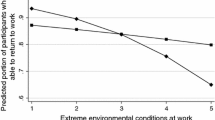Abstract
We propose to use the theoretical Mincer-Ofek (1982) model of career interruptions for the evaluation of a health producing treatment that improves residual functional capacity of workers with peripheral nerve injuries who developed chronic pain (Reflex Sympathetic Dystrophy). The revalued potential to – partially – continue to accumulate productive human capital is linked to increased lifetime earnings capacity restoring – missed out – accumulated productivity. We assume that a worker's psychological well-being directly influences earnings, but also affects the cognitive mechanism to experience pain. Randomized clinical trial data and individual medical records from impaired workers are compared with a control group of randomly selected healthy workers. The estimate of the treatment's average net present value is 49.500 euros per person (in 1995 Dutch guilders constant terms).
Similar content being viewed by others
REFERENCES
Ashenfelter, O. 1978, ‘Estimating the Effect of Training Programs on Earnings,’ Review of Economics and Statistics, 60, pp. 47-57.
Beecher, H.K.1959, Measurement of Subjective Responses, Oxford University Press.
Bentolila, S. and G. Bertola 1990, ‘Firing Costs and Labour Demand: How Bad Is Eurosclerosis?’ Review of Economic Studies, 573, pp. 381-402.
Brouwer, W.B., M.A. Koopmanschap, and F.F.H. Rutten 1997, ‘Productivity Costs in Cost-Effectiveness Analysis – Numerator or Denominator: A Further Discussion,’ Health Economics, 6, pp. 511-514.
Bound, J. 1991, ‘The Health and Earnings of Rejected Disability Insurance Applicants: Reply,’ American Economic Review, 81, pp. 1427-1434.
Bound, J. and T. Waidmann 1992, 'Disability Transfers, Self-reported Health, and the Labor Force Attachment of Older Men: Evidence from the Historical Record,'Quarterly Journal of Economics, 107, pp. 1393-1419.
Bound, J. and R.V. Burkhauser 1999, ‘Economic Analysis of Transfer Programs for People with Disabilities,’ in: (O.C. Ashenfelter and D. Card eds.), Handbook of Labor Economics, 3C, pp. 3417-3528.
Durbin, J. 1953, ‘A Note on Regression When There Is Extraneous Information about One of the Coefficients,’ Journal of the American Statistical Association, 48, pp. 799-808.
Drummond, M.F., B. O'Brien, G.L. Stoddart, and G.W. Torrance 1998, Methods for the Economic Evaluation of Health Care Programs, Oxford, Oxford University Press.
Eich E., I.A. Brodkin, J.L. Reeves, and A.F. Chawla 1999, ‘Questions Concerning Pain.’ in: (D. Kahneman, E. Diener, and N. Schwartz eds.), Well-Being. The Foundations of Hedonic Psychology, New York, Russell Sage Foundation, pp. 155-168.
Ferrer-i-Carbonell, A. and B.M.S. van Praag 2002, ‘The Subjective Costs of Health Losses due to Chronic Diseases. An Alternative Model for Monetary Appraisal.’ TI 2002-023/3, Amsterdam, Tinbergen Institute.
Hassink, W.H.J., J.C. van Ours, and G. Ridder 1997, ‘Dismissal through Disability,’ De Economist, 145, pp. 29-46.
Heckman, J.J. 1979, ‘Sample Selection Bias as a Specification Error,’ Econometrica, 47, pp. 153-161.
Jensen, M.P. and C.A. McFarland 1993, ‘Increasing the Reliability and Validity of Pain Intensity Measurement in Chronic Pain Patients,’ Pain, 55, pp. 195-203.
Kemler, M.A., G.A.M. Barendse, M. van Kleef, H.C.W. de Vet, C.P.M. Rijks, C.A. Furnée, and F.A.J.M. van den Wildenberg 2000, ‘Spinal Cord Stimulation in Patients with Chronic Reflex Sympathetic Dystrophy,’ New England Journal of Medicine, 343, pp. 618-624.
Kemler, M.A. and C.A. Furnée2002a, ‘The Impact of Chronic Pain on Life in the Household,’ Journal of Pain Symptom Management, 23, pp. 433-441.
Kemler, M.A. and C.A. Furnée 2002b, ‘Economic Evaluation of Spinal Cord Stimulation for Chronic Reflex Sympathetic Dystrophy,’ Neurology, 59, pp. 1203-1209.
Krueger, A., S. Drastal, and D. Kruse 1995, ‘Labor Market Effects of Spinal Cord Injuries in the Dawn of the Computer Age,’ NBER Working paper, No. 5302.
Melzack, R. and P.D. Wall 1965, ‘Pain Mechanisms: A New Theory,’ Science, 50, pp. 971-979.
Merskey, H. and N. Bogduk 1994, ‘Classification of Chronic Pain: Descriptions of Chronic Pain Syndromes and Definitions of Pain Terms,’ Seattle, IASP Press, pp. 40-42.
Mincer, J. 1974, Schooling, Experience and Earnings, New York, Columbia University Press.
Mincer, J. and H. Ofek 1982, ‘Interrupted Work Careers: Depreciation and Restauration of Human Capital,’ Journal of Human Resources, 17, pp. 3-24.
Parsons, D.O. 1991, ‘The Health and Earnings of Rejected Disability Insurance Applicants: Comment,’ American Economic Review, 81, pp. 1419-1426.
Salkever, D.S. and A. Sorkin 2000, The Economics of Disability, Stamford, JAI Press.
Statistics Netherlands 1995, Sociaal-economisch panel onderzoek: variabelendocumentatie 1995, Voorburg.
Viscusi, W. Kip 1979, Employment Hazards: An Investigation of Market Performance, Harvard University Press.
Weinstein, M.C., J.E. Siegel, M.R. Gold, M.S. Kamlet, and L.B. Russell 1996, ‘Recommendations of the Panel on Cost-Effectiveness in Health and Medicine,’ Journal of the American Medical Association, 276, pp. 1253-1258.
Westerhout, E. 2001, ‘Disability Risk, Disability Benefits, and Equilibrium Unemployment,’ International Tax and Public Finance, 83, May 2001, pp. 219-243.
Author information
Authors and Affiliations
Rights and permissions
About this article
Cite this article
Furnée, C.A., Pfann, G.A. & Kemler, M.A. Treatment Value of Residual Functional Capacity Improvement among Disabled Workers: Accounting for Hedonic Psychological Biases. De Economist 151, 171–192 (2003). https://doi.org/10.1023/A:1023964102139
Issue Date:
DOI: https://doi.org/10.1023/A:1023964102139




